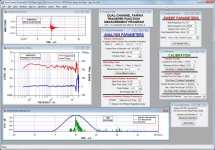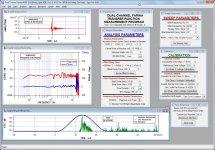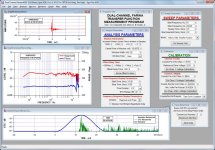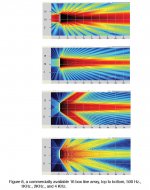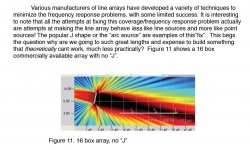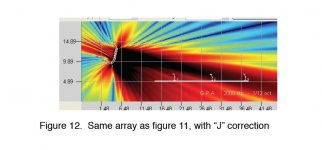Certainly true. The only time I've heard the "PE" CBT was at BurningAmp, where there was a pair across the hall from SL's LX521 (in similar, and equally bad, rooms). They did not distinguish themselves. Whether it was the demo material chosen or something about the setup I don't know, but the dipoles sounded a lot better.You cannot dismiss a speaker based simply on an experience from a show.
Those two measurements are horrific on a straight array. I've done measurements on mine.
Well not on the ribbon linesource, i have done in the past , well horrific that is , i would like to see such on the CBT and the Summa's ...
Certainly true. The only time I've heard the "PE" CBT was at BurningAmp, where there was a pair across the hall from SL's LX521 (in similar, and equally bad, rooms). They did not distinguish themselves. Whether it was the demo material chosen or something about the setup I don't know, but the dipoles sounded a lot better.
Get them 30 ft above the groundplane and you might just hear what they do ...
Yes, it's a line source - or what we used to call a column speaker. 
But the curve along with the Legendre shading makes it not a typical column speaker. I really doesn't sound that way. It's superior to any flat row I've heard. Keele's papers are full of good info, it's worthwhile to read them. I really does work the way that Don claims it does. Yes, I prefer the Synergy, but a lot of that is the quality of the drivers, I think.
But the curve along with the Legendre shading makes it not a typical column speaker. I really doesn't sound that way. It's superior to any flat row I've heard. Keele's papers are full of good info, it's worthwhile to read them. I really does work the way that Don claims it does. Yes, I prefer the Synergy, but a lot of that is the quality of the drivers, I think.
I know this is not a CBT thread, but I want to comment this.
The dynamics of the CBTs are encredible. Subjectively, much better then Abbey. The CBTs tolerate very high peaks.
You cannot dismiss a speaker based simply on an experience from a show. Gedlee speakers have also received poor reviews from demos like that. But the fact is that they are both great speakers.
There's absolutely no truth to the fact that the sound is smearing with a proper setup CBTs. They are crystal clear whith an amazing openness. This isn't simply a speaker with many stacked drivers. If that was the case, what you said would be true. The speaker looks great in the time domain.
I do believe I can say this, since I after all have both speakers in position. I have done measurements too of course.
With all due respect, many of you do not seem to understand the importance of a uniform response over a broad passband, and think that a speaker this is beaming is without flaws. You are overly concern with some sidewall reflections while you overlook the coloration it brings. A speaker that is beaming and has a polar that is collapsing is in totally need of broadband treatment to sound correct. Both at sidewalls and at the ceiling!
I should clarify that the CBT wasn't 'breaking up.'
When most people think 'dynamics', they think of a speakers ability to simply get loud.
No, the thing that I noticed with the Parts Express CBT was a tendency to smear transients.
The effect was very similar to what I hear from an ambiosonics filter, where the original is mixed back into the mix electronically, but delayed.
I believe the CBT design is doing something similar due to the reflections from the midrange and tweeters.
Or at least, that was the effect I perceived.
As for auditioning speakers at an audio show, that's how I chose to buy the Summas. Listened to them at the RMAF back in 2005.
Keep in mind that a great deal of this is subjective. I may be exceptionally picky about transients because every speaker I've owned for the past decade has used a single tweeter and a single midrange. (Or at least in the home they have. Most of my car audio projects are unity horns.)
I believe that's correct, especially if you are talking about CBT36 that uses low sensitive drivers. There are of course CBTs with higher sensitivity. A CBT36XL is in development for instance.Having heard the Geddes, the CBT and the Danley horns (even once the CBT and Synergy in the same room) I have to say that the horn designs still take the dynamics trophy, by far. They also take the sustained clean high volume prize.
I don't think that's a fault of the CBT concept, but of the driver and passive shading used in the present CBT build. It still plays very loud, tho, and is more dynamic than many other speakers.
But either way, for outdoor use a high effcient horn does definetly have it's place.
Certainly true. The only time I've heard the "PE" CBT was at BurningAmp, where there was a pair across the hall from SL's LX521 (in similar, and equally bad, rooms). They did not distinguish themselves. Whether it was the demo material chosen or something about the setup I don't know, but the dipoles sounded a lot better.
Vanderstien was demo-ing their flagship dipoles at CES, and my experiences A/Bing them against the CBT is consistent with your experience comparing the Linkwitz dipole against the CBT.
Yes, but . . . I'd have to put my chair on the roof . . .Get them 30 ft above the groundplane and you might just hear what they do ...
Please, at least read something before you post. This is utterly wrong.CBT is nothing more than a curved linesource, the first one i heard was back in the eighties, curved like the letter C towards the listener as opposed to curving away from the listener as the ones I'm seeing today, the issues they represent are immense, IMO a flat linesource with correct height to width dimension is superior.
Which means that you don't understand how they work, or have not read the papers or seen the demo. If you had done so, you'd realize the error of that statement.Get them 30 ft above the groundplane and you might just hear what they do ...
I see it constantly. Audiophiles that draw conlusions about speakers they have heard at demos, in a shop or at someones house. Some even judge the source and cables from that.Certainly true. The only time I've heard the "PE" CBT was at BurningAmp, where there was a pair across the hall from SL's LX521 (in similar, and equally bad, rooms). They did not distinguish themselves. Whether it was the demo material chosen or something about the setup I don't know, but the dipoles sounded a lot better.
The room is always the weakest link, or the speaker and room integration. Even the best speaker can sound poorly. An uneven frequency response, flutter echo, loads of high gain specular reflections, bass resonances, long decay etc. will not exactly give you a goosebump experience. I have yet to hear a proper setup at a show or in a store. The result is below mediocre at best.
Below are some impulse responses of CBT36. See at the top for description (distance and height). Sorry that I don't have anything more zoomed in.
Attachments
Last edited:
Please, at least read something before you post. This is utterly wrong.
You should at least listen after you read something , or better test it yourself .....
Another is blaming the room, bad speaker, bad room is common , more so the speaker than the room ...
Last edited:
Which means that you don't understand how they work, or have not read the papers or seen the demo. If you had done so, you'd realize the error of that statement.
I will take your word for it ......
I see it constantly. Audiophiles that draw conlusions about speakers they have heard at demos, in a shop or at someones house. Some even judge the source and cables from that.
The room is always the weakest link, or the speaker and room integration. Even the best speaker can sound poorly. An uneven frequency response, flutter echo, loads of high gain specular reflections, bass resonances, long decay etc. will not exactly give you a goosebump experience. I have yet to hear a proper setup at a show or in a store. The result is below mediocre at best.
Below are some impulse responses of CBT36. See at the top for description (distance and height). Sorry that I don't have anything more zoomed in.
Because they dont know what they are doing and mostly from using poorly designed speakers from people who read too much books ..
Perhaps not "always", but yes. When I first heard the LX521 (at BurningAmp) I commented on some . . . peculiarity . . . in the lower midrange (it's in a comment I posted somewhere here on diyAudio). That was the same time I heard the CBT, by the way, so at least it's a somewhat apples to apples comparison on that level, but as noted the demo material was quite different and the rooms not flattering to any speaker in them. Anyway . . . my comment about LX521 prompted SL to invite me over to hear them at his house, and there, properly set up, the midrange was immaculate . . . as good as I've heard ever, short of live performance. I have not had a comparable opportunity with the CBT speakers, so it is certainly possible that in a room and setup more suited to them I might be more favorably impressed.The room is always the weakest link, or the speaker and room integration. Even the best speaker can sound poorly. An uneven frequency response . . .
Yes. A line array has a lot of lobing.I concur. CBT behaves differently from a simple J array or similar arrays. For example it does not have the (near field) lobing problems. In fact it solves the problems those traditional line sources have.
Attachments
Continuing on with the original topic of this thread, I have decided to issue an open letter to Linkwitz Labs addressing the discrepancies between AES Convention Paper 7959 and Paper 8307.
I will be returning this letter, along with all of my construction manuals, directly to Linkwitz Labs. A redacted version (addresses and contact information) of the letter has been posted publicly on my Google Drive.
I sincerely hope that this message is considered on topic.
I respect your position. I too have found it to be the case, but for obvious reasons could not do what you are doing. Siegfried and I have tangled on more than one occasion.
Yes. A line array has a lot of lobing.
Shaded line arrays do not and they are not new.
You cannot dismiss a speaker based simply on an experience from a show. Gedlee speakers have also received poor reviews from demos like that. But the fact is that they are both great speakers.
The fact is that no Abbey has ever been shown at a show (I don't do shows) so your comment is clearly something that you made up. How can anything that you say be taken seriously now that we know that you make things up.
Last edited:
Having heard the Geddes, the CBT and the Danley horns (even once the CBT and Synergy in the same room) I have to say that the horn designs still take the dynamics trophy, by far. They also take the sustained clean high volume prize.
I don't think that's a fault of the CBT concept, but of the driver and passive shading used in the present CBT build. It still plays very loud, tho, and is more dynamic than many other speakers.
Its the thermal dynamics - small speakers cannot handle the thermal aspects like one very large one can. Its not magic, its quite logical.
I know, I know, the comment will come back: "but there are lots of the speakers and each one handles only a small amount of power." The problem is that a big compression driver can be as much as 100-1000 times better at handling the thermal aspects and there are only 36 of the smaller drivers so this is still a big advantage to the compression driver. Its a scaling problem and the numbers, power, thermal handling, etc. don't all scale the same. This gives a big advantage of the single large voice coil device over the many smaller voice coil devices. Simple physics that cannot be circumvented.
- Home
- Loudspeakers
- Multi-Way
- Linkwitz Orions beaten by Behringer.... what!!?
